Coasters / Bottle Holders
Wine coasters were not made until the 1760’s when they were produced from pierced sheet similar to the cake baskets of that date. These silver wine bottle or decanter holders, were usually made in pairs, sometimes fours, but it is rare to find an antique set longer than four. The silver hallmarks were often stamped on the edge of the base and as a result the marks can sometimes be difficult to read, either because they were badly struck or because, over the years, they have become rubbed. “The early name for such pieces was a ‘stand’ or ‘slider’; the term ‘coaster’, first recognized in 1887, was derived from the custom that, after finishing dinner, the cloth was removed from the table, the ladies withdrew, and the bottle of port was ‘coasted’ around the table by the men.” G. Bernard Hughes – ‘Old English Wine Coasters’ .
Bottle holders normally come in two distinct forms. The basket shape allows the bottle to be laid on its side ready for pouring. The upright stand has a handle and is usually adjustable in height; it’s often suitable for both wine and champagne bottles.
Decanter Wagons make a decorative addition to the dining table. These have two silver bottle coasters mounted onto a 2 wheeled frame which can be moved up and down the table.
The Jolly Boat is a special type of decanter wagon normally used on board ship in the naval officers’ dining room. It was customary at the table after pouring wine or spirit from the decanter, to return it to the stand and push it along to the next officer. It is believed that the saying ‘to push the boat out’ has its origins in the custom as the officer paying for the wine was the first to start the jolly boat off round the table. Jolly boat wine coasters were sometimes supplied with wheeled carriages, supposedly for use ashore. At sea, these were dispensed allowing the flat-bottomed coasters to provide the necessary stability aboard a rolling ship.
Coasters / Bottle Holders
Wine coasters were not made until the 1760’s when they were produced from pierced sheet similar to the cake baskets of that date. These silver wine bottle or decanter holders, were usually made in pairs, sometimes fours, but it is rare to find an antique set longer than four. The silver hallmarks were often stamped on the edge of the base and as a result the marks can sometimes be difficult to read, either because they were badly struck or because, over the years, they have become rubbed. “The early name for such pieces was a ‘stand’ or ‘slider’; the term ‘coaster’, first recognized in 1887, was derived from the custom that, after finishing dinner, the cloth was removed from the table, the ladies withdrew, and the bottle of port was ‘coasted’ around the table by the men.” G. Bernard Hughes – ‘Old English Wine Coasters’ .
Bottle holders normally come in two distinct forms. The basket shape allows the bottle to be laid on its side ready for pouring. The upright stand has a handle and is usually adjustable in height; it’s often suitable for both wine and champagne bottles.
Decanter Wagons make a decorative addition to the dining table. These have two silver bottle coasters mounted onto a 2 wheeled frame which can be moved up and down the table.
The Jolly Boat is a special type of decanter wagon normally used on board ship in the naval officers’ dining room. It was customary at the table after pouring wine or spirit from the decanter, to return it to the stand and push it along to the next officer. It is believed that the saying ‘to push the boat out’ has its origins in the custom as the officer paying for the wine was the first to start the jolly boat off round the table. Jolly boat wine coasters were sometimes supplied with wheeled carriages, supposedly for use ashore. At sea, these were dispensed allowing the flat-bottomed coasters to provide the necessary stability aboard a rolling ship.
-

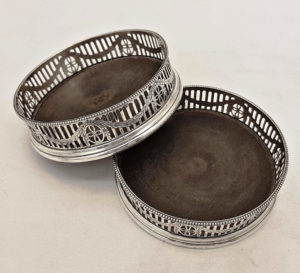
1777
Robert Hennell I
9881 George III Silver Wine Coasters
Sold
A very pretty pair of antique silver bottle stands with pierced silver borders and solid hardwood centres. Simple elegant design with bead borders, foliate swags and classical motifs. To the front there an oval cartouche containing the letter “F” engraved. Height 3.4cm. Diameter 12cm. London 1777. Maker Robert Hennell I. Sterling silver.
-

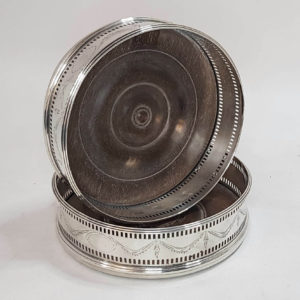
1787
10100 George III Antique Silver Coasters
Sold
A very pretty pair of antique sterling silver wine coasters with pierced gallery and turned hardwood centres. Typical 18th century classical design. The borders having bright cut engraving with swags and an oval medallion to the front. Height 3.3cm. Diameter 12cm. London 1787/8. Maker’s mark rubbed.
-

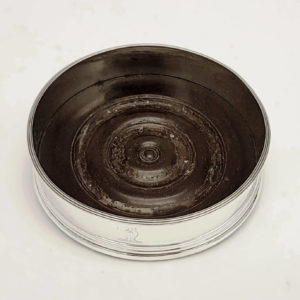
1813
9527 George III Silver Coaster
Sold
A classic antique sterling silver wine bottle stand with elegant plain styling. Hand engraved crest to the front. Turned hardwood base. Diameter 12 cm. Height 3.4 cms. London 1798 or 1813. Maker’s mark rubbed.
-

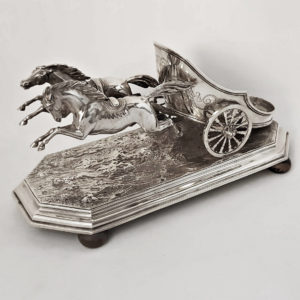
1861
George Angell
8658 Antique Silver Model Chariot and Horses
£6,750
An outstanding piece of decorative silver. An antique sterling silver pair of galloping horses pulling a wheeled chariot. All mounted on a heavy solid silver base with naturalistic decoration, standing on four turned wooden feet. Excellent quality and good heavy weight. Weight 1506 grams, 48.4 troy ounces. Height 15.5cm. Base 33 x 16cm. London 1861. Maker George Angell.
Recently Viewed Products
-

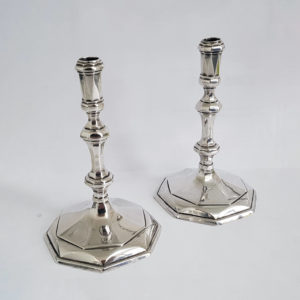
1712
Joseph Bird
10232 Queen Anne Antique Silver Tapersticks
£5,850
A rare pair of dainty little antique silver tapersticks with the desirable octagonal shape. Superb quality. Lovely crisp finish. The straight lined form features a faceted sconce and foot and a plain knopped tapering stem. Total weight 200 grams, 6.4 troy ounces. Height 12cm. Base diameter 7.1cm. London 1712. Maker Joseph Bird. Britannia standard silver. 18th century.
-

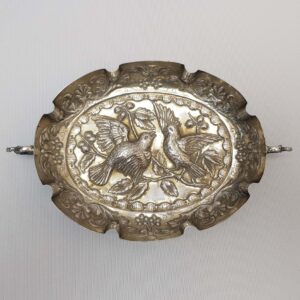
Circa 1690
10357 German Augsburg Antique Silver Dish
Sold
An early antique German silver dish (or possibly wine taster) of plain oval form with a scalloped border. To the centre there is a charming bird scene surrounded by shell border and pin prick designs. The cast side handles have a bird’s head design on top. Original interior gilding. Weight 136 grams, 4.3 troy ounces. Height 2.75cm. Top of dish measures 17.25 x 13.5cm. Spread 21.5cm. Augsburg, Germany. Makers mark “IK”. Circa 1690.
-

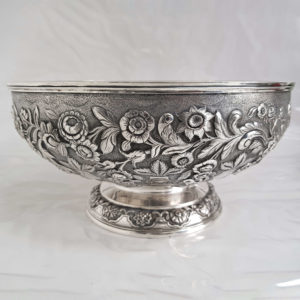
1827
David Crichton Rait
10222 George IV Antique Silver Bowl
£4,950
A magnificent Scottish antique silver centrepiece bowl with deep repousse decoration of flowers and foliage. The centre has the original bright gilding. Fantastic quality, large size and heavy gauge silver. To the front is an interesting presentation inscription. Weight 1567 grams, 30.3 troy oz. Diameter 26.2cm. Height 13.4cm. Glasgow 1827. Maker David Crichton Rait. Sterling silver. 19th century.
-

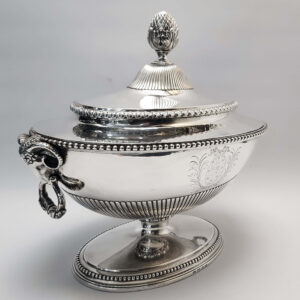
1775
Andrew Fogelberg
10369 George III Antique Silver Soup Tureen
£6,850
A handsome antique sterling silver serving tureen in the neo-classical style characteristic of the work of Andrew Fogelberg. Large size and good weight. The elegant oval form body has bead borders and a semi-fluted design, all topped by a magnificent pineapple finial. An exceptional feature is the striking pair of large, cast silver side handles in the form of a ram’s head. To the front body is a fine hand engraved armorial and the lid bears a crest. Weight 3073g, 98.8 troy oz. Spread across the handles 37cm. Height to top of finial 31cm. Top 31 x 22cm. London 1775. Maker Andrew Fogelberg, master to Paul Storr.